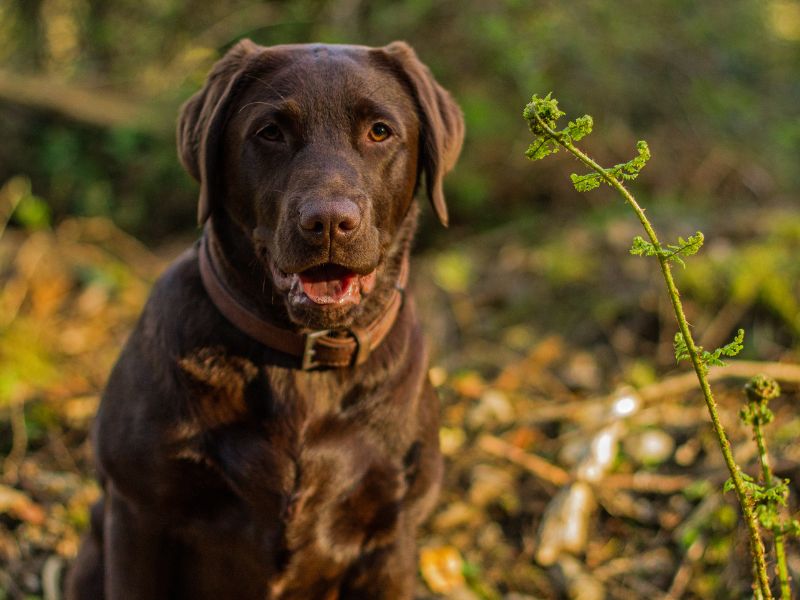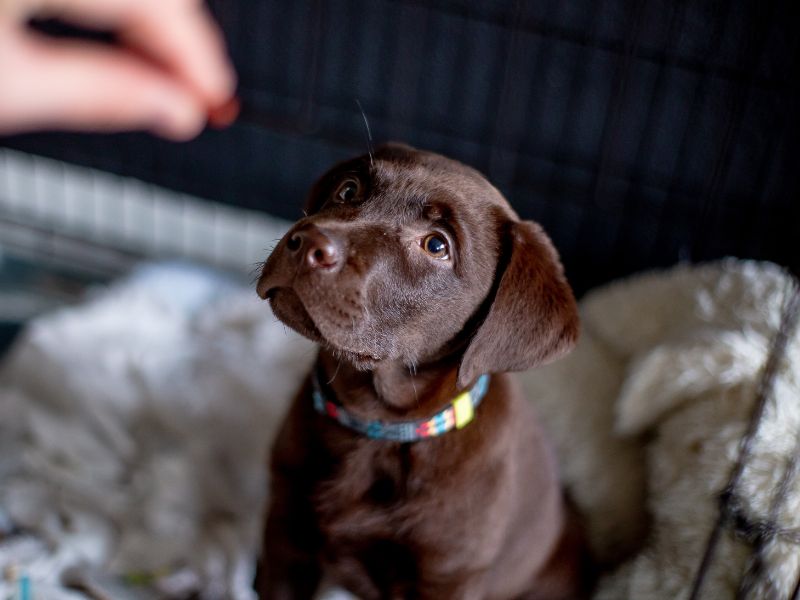
The Chocolate Lab, a beloved variation of the Labrador Retriever, is known for its unique brown fur and friendly, confident attitude, making it a highly desired pet. While not a distinct breed, these dogs possess a rare color variation within the purebred Labrador Retriever gene pool, with shades ranging from light liver to dark mahogany. With a height ranging between 21.5 to 24.5 inches at the shoulder and weighing between 55 to 80 pounds, Chocolate Labs are medium-to-large-sized canines with a sturdy, athletic build, a waterproof double coat, and a broad snout. Their affectionate nature and charm make them a top choice among dog lovers, although recent research has raised some concerns about their health compared to their yellow and black Lab counterparts. Although the chocolate color was officially recognized as a standard in Labrador Retrievers in 1917, it wasn’t until the 1960s that Chocolate Labs began gaining widespread popularity. Today, these sweet and loyal dogs continue to capture hearts worldwide, solidifying their place in the Labrador Retriever family. Fascinating Facts About Chocolate Labs

The Chocolate Labrador is a lovable and active dog breed known for its friendly and playful nature. They typically weigh up to 80 lbs and stand around 24 inches tall. These clever and confident companions are popular among families and sporting enthusiasts alike, with an average lifespan of around 12 years. Sharing the same physical characteristics as other Labrador Retrievers, Chocolate Labs have a strong, lean body, double-layered coat, and wide snout. Their most distinguishing feature is, of course, their chocolate-like brown fur. Standing between 21.5 and 24.5 inches tall and weighing between 55 and 80 pounds, they are slightly larger than their black or yellow counterparts. While Chocolate Labs are not as common as other Labrador colors, their popularity has been increasing with the help of genetic testing. Known for their friendly and sociable temperament, these dogs make great additions to any family. Their expressive eyes and floppy ears add to their charm, making them beloved companions. As sporting dogs, Chocolate Labs are energetic and require regular exercise and mental stimulation to thrive. Daily walks, playtime, and training activities are essential to keep them healthy and happy. When considering a Chocolate Lab as a pet, it’s important to take into account their temperament, physical attributes, and exercise needs to ensure a harmonious match with their new family. Rachael is a beautiful three-year-old Chocolate Labrador with a mix of American and English Lab lines, showcasing the stunning beauty of this variety. Despite misconceptions about their intelligence, Chocolate Labs are just as smart and loving as other Labradors. With varying shades of brown fur, brown noses, eyes, and skin pigmentation, these dogs exude charm and uniqueness. In summary, Chocolate Labs, like Rachael, are wonderful companions known for their striking appearance and friendly demeanor. Their intelligence, temperament, and distinctive look contribute to their popularity among dog lovers.

Chocolate Labs, also known as Chocolate Labrador Retrievers, have a fascinating history dating back to the 1500s in Newfoundland. During this time, various European countries sent fishers to the Atlantic for food, leading to the development of the Labrador Retriever breed through selective breeding. While black Labs were the dominant color, some carried the genes for producing chocolate puppies. The unique chocolate color in Labs is inherited through a recessive gene from both purebred Labrador parents. Unlike their black counterparts, chocolate Labs come in various shades of brown with matching eyes and nose. Today, they are one of the three main Labrador Retriever colors, alongside black and yellow. Understanding the genetics of coat color inheritance in Labradors is essential for breeders and potential owners. The interplay of specific genes determines whether a Labrador will have a black or chocolate base coat. Epistasis and multiple genes work together to influence coat color expression in Labradors. Chocolate Labs are beloved for their friendly and energetic nature, making them popular as family pets and sporting dogs. Their coat color can change over time due to factors like sunlight exposure and aging. Proper grooming and care can help maintain the beauty of their coat without affecting their health or personality. Although chocolate Labs were once less desirable due to rarity and misperceptions about breeding practices, advances in genetics and breeding have increased their popularity. Today, they are cherished for their intelligence, loyalty, and trainability, making them excellent companions for families and individuals alike.

What is the average size of the Chocolate Lab? Well, Chocolate Labs typically stand between 21.5 to 24.5 inches tall at the shoulder and weigh around 55 to 80 pounds. They are medium to large-sized dogs with athletic builds. These unique Labs are known for their distinct brown, chocolate-like fur which sets them apart from their yellow and black counterparts. Their friendly and loving nature makes them popular choices for families and as working dogs. However, it’s important to note that Chocolate Labs may be more prone to certain health concerns such as hip and elbow dysplasia, vision problems, and a higher risk for cancer compared to other Lab variations.

Is it a misconception that Chocolate Labs are less intelligent than other Labrador colors? Despite past prejudices, the truth is that all Labrador Retrievers, including Chocolate Labs, possess similar levels of intelligence and capability. By selecting a reputable breeder and providing proper training and socialization, a Chocolate Lab can be just as bright and trainable as their black or yellow counterparts. Don’t judge a Chocolate Lab’s smarts based on its coat color – with the right breeding and care, they can be just as clever and skilled as any other Lab.

Despite the misconceptions surrounding their intelligence, Chocolate Labs are truly a wonderful breed. Their coat color does not determine their level of intelligence or trainability. Each Labrador, regardless of color, has the potential to be intelligent and hardworking. There are different shades of Chocolate Labs, ranging from light liver to dark mahogany, each contributing to the beauty of this popular breed. Factors such as genetics and breeding practices influence the specific shade of a Chocolate Lab’s coat. As with any dog, proper training, mental stimulation, and upbringing play a significant role in a Chocolate Lab’s behavior. While some may perceive them as stubborn, it is essential to understand that individual factors can influence a dog’s temperament, regardless of coat color. Silver Labs, a variation of Chocolate Labs, have a unique silver coat color caused by a dilute gene. Despite their distinctive appearance, Silver Labs share the same friendly and active temperament as other Labradors. They continue to charm families and dog enthusiasts alike. Overall, Chocolate Labs have a bright future ahead of them. Their friendly, fun-loving nature makes them a top choice for many families. Their versatility in both family life and sporting events, combined with their rich brown coat and lovable personality, make them a delightful addition to any home.

Purchasing a Chocolate Lab puppy can be a wonderful experience, but it’s important to do your research and find a reputable breeder to ensure you are getting a healthy and well-bred puppy. While Chocolate Labs are less common than their yellow and black counterparts, there are still options available for those interested in bringing this beautiful color variant into their homes. One option to consider is adopting a Chocolate Lab from a shelter or rescue organization. Many dogs, including Chocolate Labs, are in need of loving homes and adopting from a shelter can be a rewarding experience. Check with local rescue organizations or visit Labrador-specific rescues to see if there are any Chocolate Labs available for adoption. If you prefer to purchase a puppy from a breeder, it’s important to do your due diligence. Look for breeders who prioritize responsible breeding practices and the health of their dogs. Be prepared to pay a higher price for a Chocolate Lab puppy, as they are considered more rare and can cost anywhere from $1,000 to $2,250, depending on the puppy’s quality and intended purpose, such as for show competitions. When contacting breeders, ask about the health history of the puppy’s parents and inquire about any available genetic testing results. Since Chocolate Labs have a unique coat color due to their “bb” genetic combination, it’s important to ensure the breeder follows ethical practices and provides proper information and support throughout the entire process. Additionally, network within the Labrador Retriever community to increase your chances of finding a reputable breeder or learning about potential adoption opportunities for a Chocolate Lab. Attending dog shows, connecting with other Labrador owners, and engaging in online forums can all be helpful in your search for the perfect Chocolate Lab puppy. Whether you choose to adopt or purchase a Chocolate Lab puppy, by taking the time to find a responsible breeder or rescue organization, you can bring home a lovable and loyal companion that will enrich your life for years to come.

To ensure a smooth transition when bringing a Chocolate Lab puppy into your home, it is crucial to conduct thorough research beforehand. Begin by locating reputable breeders or adoption centers in your vicinity. Consider the option of adopting a Chocolate Lab from a shelter or local pet rescue organization, as this can be a rewarding experience. When looking for breeders, it is important to verify that they adhere to ethical breeding practices and prioritize the well-being of their puppies. It is advisable to steer clear of purchasing from pet stores or classified ads, as these may be associated with puppy mills. Chocolate Labs are not a separate breed but rather a coat color variation of Labrador Retrievers. Their prices typically range from $800 to $1200, depending on factors such as pedigree, location, and demand, similar to their yellow and black counterparts. When selecting a Chocolate Lab puppy, focus on its temperament and overall health. Look for a puppy that displays curiosity, friendliness, and liveliness. Additionally, inquire about any potential health issues with the breeder, as one study suggests that Chocolate Labs may have slightly higher health risks than their yellow and black counterparts. It is essential to visit the breeder’s facility and meet the puppy’s parents to gauge their temperaments and living conditions. This will offer valuable insight into the behavior and potential health issues of your Chocolate Lab puppy. While chocolate Labs may be prone to certain health concerns like ear infections, they are still intelligent and capable dogs. To increase the likelihood of getting a smart and healthy pup, opt for a breeder who provides documentation of the dog’s lineage and relevant health tests. Upon bringing a chocolate Lab puppy home, ensure regular veterinary check-ups, appropriate nutrition, and ample exercise to minimize health risks. Stay alert to any changes in behavior or health that may indicate a potential issue, and seek guidance from your veterinarian when needed. Although Chocolate Labs have specific health challenges due to their color, with proper care and attention, they can lead a happy and healthy life. Potential owners should educate themselves about these concerns and collaborate closely with veterinarians to address any issues that may arise.

While Chocolate Labradors may have a slightly shorter lifespan than other Lab colors, there are steps you can take to ensure a long and healthy life for your furry companion. Regular health checkups and testing can help catch any potential issues early on, while following your vet’s advice on vaccinations is crucial for preventing diseases. Maintaining a healthy weight is also important for Chocolate Labs, as it can help prevent a variety of health problems. Proper diet and exercise are key in keeping your dog at a healthy weight and preventing obesity and joint issues. When looking for a Chocolate Labrador puppy, be sure to choose a breeder who follows ethical practices and conducts genetic testing for hereditary conditions. Responsible breeding practices can help avoid potential health issues down the line. Training and exercise are essential for a happy and well-behaved Chocolate Labrador. Starting training early and being consistent in your routine can help your dog become a well-behaved member of the family. Socialization, basic commands, and positive reinforcement are key components of effective training. Because Chocolate Labradors are known for their friendly nature, teaching them to greet people calmly can help prevent over-excitement. Training your dog to sit and stay when meeting new people can help them interact appropriately with others. For exercise, daily walks, play sessions, and mental stimulation are important for keeping your Chocolate Labrador healthy and happy. Activities like fetch, swimming, hiking, and participating in dog sports can help prevent boredom and excessive weight gain. As your Chocolate Lab ages, it’s important to continue providing them with proper care and attention. Regular vet checkups, a healthy diet, and appropriate exercise are key in ensuring a happy and comfortable old age for your beloved companion.

As Chocolate Labradors get older, they may start experiencing health issues that require special care and attention. It’s important to make sure they are comfortable and well looked after, especially as they become less mobile and more prone to illnesses. One important aspect of caring for an older Chocolate Lab is making adjustments to your home to suit their needs. Adding skid-proofing to areas where your dog spends time can help prevent accidents, as their balance may not be as steady as it once was. Regular grooming is also crucial for maintaining the health of an older Chocolate Lab’s skin and coat. Opt for gentle, short grooming sessions using a soft-bristled brush to avoid harming their delicate skin, and be sure to check for fleas and ticks with a flea comb. Keep a close eye on your dog’s diet and exercise routine to ensure they stay at a healthy weight and avoid obesity-related health issues. Since older dogs are typically less active, they may need fewer calories, so it’s important to adjust their food intake accordingly. Consulting with your vet can help you create the best diet plan for your senior Chocolate Lab. Regular veterinary check-ups are essential for catching any potential health problems early on. Taking your older Chocolate Lab to the vet at least twice a year for a thorough examination can help identify and address any issues before they become serious. Chocolate Labs are a unique variation of the Labrador Retriever breed, known for their striking chocolate-brown coat. These friendly, confident, and loving dogs are popular for their appealing appearance. Physically, Chocolate Labs share the same characteristics as other Labradors, with a sturdy body, a double-layered coat, and a kind expression. What sets them apart is their beautiful brown fur, which is their most distinctive feature. In addition to their coat color, Chocolate Labs are known for their athleticism and energy, making them great companions for active families. They enjoy water activities, fetch, and other outdoor adventures. While Chocolate Labs are generally healthy, it’s important to be aware of potential health issues that may be more common in this color variety. Being mindful of these concerns can help ensure your Chocolate Lab stays happy and healthy for years to come.


